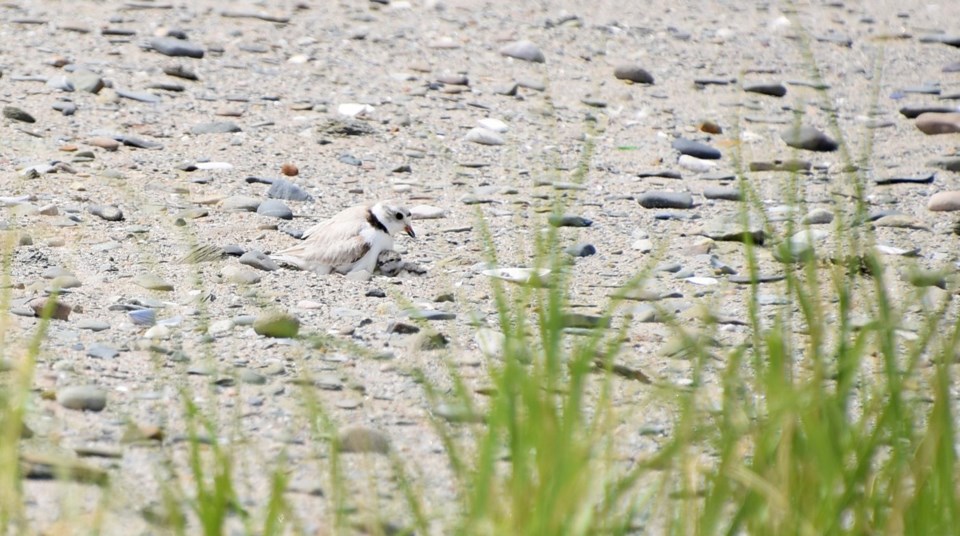FREDERICTON — It's a small step toward saving an endangered species but a big leap for a little bird.
Sixteen piping plover chicks survived in 2024 in the Kouchibouguac National Park on the east coast of New Brunswick. This is the highest number seen in seven years.
Daniel Gallant, an ecologist for Parks Canada, said he was happy with the birth and survival rate of these tiny birds. The park had six nests with a total of 24 eggs, of which 20 hatched and 16 chicks were "fledged," he said.
"Fledged means that they were able to survive throughout the summer, and at the end of the summer, they were independent and flying and presumably able to migrate," he explained.
The last time all nests survived was in 2003, he said.
Piping plovers have had it rough. The bird has been designated as endangered or at risk of extinction by the Committee on the Status of Wildlife in Canada since 1985.
The last count of these birds done in 2016 in Eastern Canada put the number of breeding pairs at 175, and the goal is to almost double that figure.
The birds split their time between breeding grounds in the north and wintering in the south, said Nick Lund, a network manager for U.S. wildlife conservation organization Maine Audubon. In summer they come up to breed in the middle of the continent, parts of the Great Lakes, and up along the Eastern seaboard as far north as Newfoundland, he added.
Lund described piping plovers as sand-coloured shorebirds — coloured that way to perfectly blend in with their beach habitat. They can be very hard to see because they’re so camouflaged, even when they’re put in the open, he said.
They have short yellow legs and usually run along the beach rather than fly, he added.
Gallant said during the breeding season, the birds have a single black band on their chest, and another one across their forehead, between the eyes.
"Almost like a little bandit," he said with a laugh. "Cute, eh?"
They come up early in spring, usually in March, earlier than most all other shorebirds in order to stake a good territory on the beach, and usually leave in September, Lund said.
"It’s common to see them on snowy beaches in March, which is quite unusual for shorebirds," he said. "Piping plovers nest on beaches, and beaches are used by humans."
Disruption of plover nests by humans, off-leash dogs, people driving on beaches, and other habitat disruptions have caused major population losses, especially along the East Coast, he said.
Gallant agreed, saying the nesting birds run away when they encounter humans walking along the beach.
"The fact of just walking along will disturb them," he said. "They have to flee."
Dogs that are not on leash "can have a very big impact" because they destroy nests, he added.
All-terrain vehicles on beaches are also bad for nests, Gallant noted.
"Not only can all-terrain vehicles or motor vehicle on the beach destroy nests, but just the grooves they create in the sand can prevent the small chicks from being able to walk to their food source," he said.
"Because when they are chicks they are not able to fly. So just the ridges created by motor vehicles on a beach could be enough to prevent the chicks from walking and finding food."
The birds build their nests in a sandy area that may have small rocks in the vicinity and next to no vegetation, Gallant said. Their nest is a small hole where they lay their eggs, he added.
The rocks and gravel camouflage the nest from predators.
The nests are close to a good food source and usually along the shoreline, he said.
"So the little chicks have to walk between these nesting area and reach a food source when they hatch."
They eat small invertebrates such as marine worms, mollusks, crustaceans and shrimps left along the shoreline at low tides, Gallant said.
Parks Canada officials take precautions to help the birds when they arrive, he said.
Some areas of the park where the birds nest are closed to visitors, with signs put up to let people know about the piping plovers so that they are not disturbed too much during their breeding, he said.
"We've been able to maintain the presence of this bird in Canada, so it's important for us to continue these efforts."
This report by The Canadian Press was first published Feb. 2, 2025.
Hina Alam, The Canadian Press




